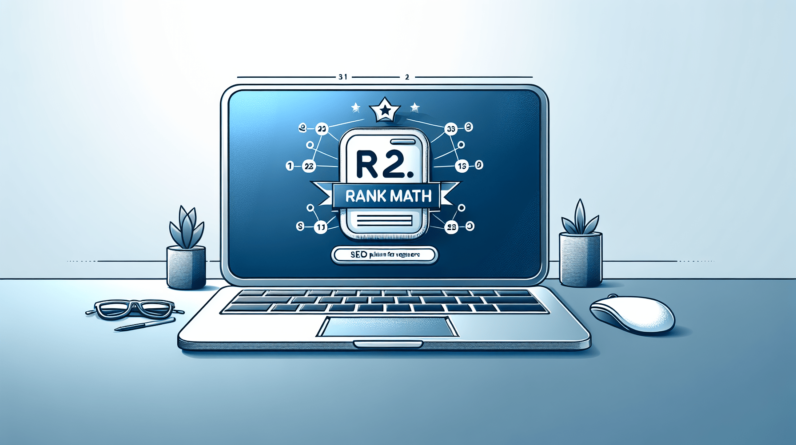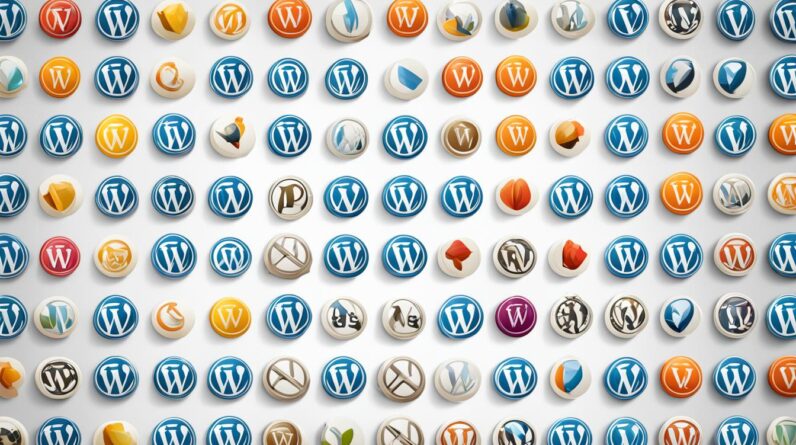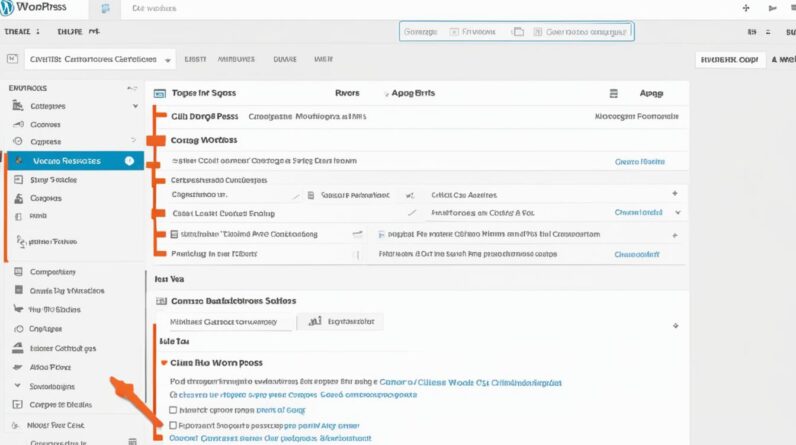Hello, I’m here to guide you through the process of adding a new page in WordPress. Whether you’re a beginner or an experienced user, WordPress provides a user-friendly interface that makes creating and managing website content a breeze. Let’s get started!
How to Make Money with YouTube
Create an empire of automated video websites for multiple streams of income
Key Takeaways:
- Adding a new page in WordPress is a simple and straightforward process.
- Access the “Pages” section in your WordPress dashboard to get started.
- You have the option to choose from ready-made page layouts or start with a blank page.
- Customize your page settings, such as visibility, publishing date, template, and URL.
- Save your page as a draft, preview it, or publish it to your website once you’re done.
Accessing the Page Settings in WordPress
In WordPress, managing the settings of your new page is a breeze. Whether you’re creating a page from scratch or editing an existing one, you’ll find all the necessary options in the page settings.
To access the page settings, simply navigate to the right sidebar of your screen when working on a page. If you don’t see the sidebar, click on the settings icon located at the top right corner to display it.
Once you have access to the page settings, you can customize various aspects of your page to suit your needs. Here are some of the key settings you can control:
- Visibility: Choose whether the page should be public or private.
- Publishing options: Set the publishing date and time for your page.
- Template selection: Select a pre-designed template for your page.
- URL customization: Customize the URL or permalink of your page.
- Excerpts: Create a brief summary of your page for display purposes.
- Discussion settings: Enable or disable comments on your page.
| Page Setting | Description |
|---|---|
| Visibility | Choose whether the page should be public or private. |
| Publishing Options | Set the publishing date and time for your page. |
| Template Selection | Select a pre-designed template for your page. |
| URL Customization | Customize the URL or permalink of your page. |
| Excerpts | Create a brief summary of your page for display purposes. |
| Discussion Settings | Enable or disable comments on your page. |
By utilizing these page settings, you have full control over how your page appears and functions on your WordPress website. Take advantage of these options to customize and optimize your page according to your specific requirements.
Publishing and Editing a Page in WordPress
After creating a page in WordPress, you have the option to publish it or continue editing it. To publish the page, simply click on the “Publish” button in the top right of the screen. This will make the page live on your website for visitors to see.
If you want to make further changes to the page, you can easily edit it at any time. To edit a page, visit your dashboard and click on “Pages” on the left side. Locate the page in the list and click on its title to open the editing screen. You can also see an “Edit” link when viewing your website publicly.
From the editing screen, you can modify the content, settings, and other details of the page. This includes updating the text, adding images, embedding videos, and more. You can also change the page layout, customize the colors and fonts, and add interactive elements to make the page engaging and visually appealing.
Updating Content:
Once you’re in the editing screen, you can easily update the content of the page. Use the block editor to add new text, images, headings, and other elements. The block editor allows you to create visually stunning pages with drag-and-drop functionality.
Modifying Settings:
In addition to content, you can also modify various settings for the page. These settings include the page title, URL, visibility options, template selection, and more. By customizing these settings, you can optimize the page for search engines and improve its visibility on the web.
Publishing Options:
When you’re ready to publish the updated page, simply click on the “Update” or “Publish” button. This will save your changes and make the updated page live on your website. Visitors will be able to access the new version of the page immediately.
It’s important to regularly review and update your pages to ensure they are relevant and engaging. By regularly publishing and editing your pages, you can provide valuable information to your visitors and improve their overall experience on your website.
- Publish or continue editing a page in WordPress.
- Locate the page in the list and click on its title to open the editing screen.
- Modify the content, settings, and other details of the page.
- Update the text, add images, and embed videos to enhance the page.
- Customize the page layout, colors, and fonts for a visually appealing design.
- Save changes and publish the updated page for visitors to see.
Sharing and Promoting Your New Page in WordPress
Once you have published your new page in WordPress, you’ll want to share it with your website visitors. There are several ways to promote your page and boost its visibility. Here are some effective strategies:
1. Add Your Page to the Navigation Menu
By adding your new page to the navigation menu, you make it easily accessible for your visitors. This ensures that they can navigate directly to your page without any hassle.
2. Share the Page URL on Social Media
Take advantage of social media platforms to share the URL of your new page. This allows you to reach a wider audience and generate more traffic to your website. Craft attention-grabbing posts or tweets with a call-to-action that entices users to visit your page.
3. Include the Page URL in Emails
If you have an email list or regularly send out newsletters, make sure to include the URL of your new page. This encourages your subscribers to click through and explore the valuable information or offerings on your page.
4. Set the New Page as Your Site’s Front Page
Consider making your new page the front page of your website. This leads to a direct first impression for visitors, allowing them to immediately engage with the content and offerings on your page.
5. Utilize the Unique Page URL for Promotion
Within the page settings of WordPress, you’ll find a unique page URL. Take advantage of this URL in your promotions by sharing it on various channels, including online directories, forums, or other relevant websites.
By implementing these strategies, you can effectively share and promote your new WordPress page, increasing its visibility and driving more traffic to your website.
Organizing Your Pages with Parent and Child Pages in WordPress
In WordPress, you can easily organize your website pages by creating a hierarchical structure using parent and child pages. This feature allows for a logical organization of your content, making it easier for visitors to navigate your site and understand the relationships between different pages.
A parent page acts as the top-level page, and you can create subpages under it. For example, let’s say you have an “About” page as the parent page. You can then create subpages such as “Team,” “History,” and “Mission.” This creates a clear hierarchy that reflects the structure of your website.
Creating a subpage in WordPress is simple. All you need to do is choose the parent page while setting up the subpage in the page settings. By doing so, you establish a relationship between the parent and child pages, indicating that the child page is a subtopic or subcategory of the parent page.
Additionally, you have the flexibility to change the order of the pages within the hierarchy. By adjusting the page attributes, you can reorder your pages as needed, ensuring a logical flow for your content.
Assigning templates to your parent and child pages allows you to further customize the page hierarchy. Templates define the layout and design of your pages. You can choose different templates for different types of pages, such as a “Contact” template for your contact page and a “Services” template for your services page.
A well-organized page hierarchy not only enhances the user experience but also improves your website’s search engine optimization (SEO). Search engines can understand the structure of your website better when you have a clear page hierarchy, which can positively impact your search rankings.
By utilizing the parent and child page functionality in WordPress, you can create a well-structured website that is easy to navigate, understand, and manage. Take advantage of this powerful feature to organize your pages effectively and provide a seamless browsing experience for your visitors.
Customizing the URL and Permalink of Your Page in WordPress
In WordPress, you have the flexibility to customize the URL and permalink structure of your pages. The URL is the web address of the page, and the permalink is the specific part of the URL that represents the page name.
To customize the URL, you can hover over the page title in the pages list and click “Edit.” In the page settings, you can find the permalink field and change it to a desired slug that matches the page title. It’s recommended to choose a slug that is relevant to the content of the page for better SEO.
Additionally, you can set the permalink structure in your WordPress settings to create clean and user-friendly URLs for all your pages.
Permalink Settings in WordPress
| Permalink Structure | Description |
|---|---|
| Plain | Uses numerical values in the URL structure (e.g., www.example.com/?p=123). |
| Day and Name | Includes the day, month, year, and title in the URL structure (e.g., www.example.com/2022/01/01/sample-page). |
| Month and Name | Includes the month, year, and title in the URL structure (e.g., www.example.com/2022/01/sample-page). |
| Numeric | Uses only the post ID in the URL structure (e.g., www.example.com/archives/123). |
| Custom Structure | Allows you to define a custom URL structure using different placeholders (e.g., www.example.com/%category%/%postname%/). |
Customizing the URL and permalink of your page in WordPress not only helps with SEO but also creates more meaningful and user-friendly URLs. It’s an important aspect of optimizing your website’s structure and improving the overall user experience.
Choosing Page Templates in WordPress for Enhanced Design
In WordPress, you have the flexibility to choose from a variety of page templates to enhance the design and layout of your pages. Page templates are pre-defined layouts and styles that can be applied to individual pages or groups of pages, providing a quick and easy way to transform the look of your website without making changes to the overall theme design.
Page templates can be created by your WordPress theme or can be custom-made. They are designed to serve specific purposes and cater to different types of content, allowing you to create unique and visually appealing pages for various sections of your website.
Types of Page Templates
When creating a new page in WordPress, you can find the page template options in the page settings under Page Attributes. The available page templates may vary depending on the theme you are using, but here are some common types you may come across:
- Default Template: This is the basic template that most pages use. It typically includes a header, content area, and sidebar.
- Full-width Template: This template removes the sidebar and expands the content area to the full width of the page.
- Landing Page Template: This template is designed to create effective landing pages with a clear call-to-action and minimal distractions.
- Portfolio Template: This template is specifically tailored for showcasing your portfolio with image galleries, project details, and filters.
- Blog Template: This template is used for displaying your blog posts in a structured format with featured images, excerpts, and pagination.
These are just a few examples, and the available page templates can vary based on the capabilities of your theme. Some themes may offer more specialized templates for specific purposes, such as team pages, event pages, testimonial pages, or contact pages.
Custom Page Templates
If you can’t find a suitable template among the theme-provided options, you can create custom page templates in WordPress. Custom page templates allow you to design unique layouts and styles that perfectly align with your vision and meet your specific needs.
To create a custom page template, you need to have a basic understanding of HTML, CSS, and template tags. You can start by duplicating an existing template file from your theme and making modifications as per your requirements. By adding custom code to the template file, you can customize the structure, design elements, and functionality of your page.
Custom page templates provide endless possibilities for creativity and customization. You can create one-of-a-kind templates for different sections of your website, giving each page its own unique look and feel.
Benefits of Using Page Templates
The use of page templates in WordPress offers several benefits, including:
- Consistency: Page templates help maintain a consistent design across your website, ensuring that all pages have a cohesive look and feel.
- Time-saving: By utilizing pre-built page templates or creating custom templates, you can save time by avoiding the need to design every page from scratch.
- Enhanced functionality: Some page templates come with built-in functionality, such as portfolio showcases or blog layouts, providing additional features without the need for complex coding.
- Improved user experience: Well-designed page templates can enhance the user experience by presenting content in an organized and visually appealing manner.
Whether you’re a beginner or an experienced WordPress user, page templates offer a simple yet powerful way to enhance the design and layout of your pages. They give you the freedom to create visually stunning and engaging content without the need for advanced coding skills.
Now that you understand the benefits and options available with page templates, you can take your WordPress website to the next level by utilizing them effectively for a professional and compelling online presence.
| Pros | Cons |
|---|---|
| Consistent design across pages | May be limited by available theme templates |
| Time-saving and efficient | May require basic HTML and CSS knowledge for customization |
| Enhanced functionality without coding | Custom templates may require more complex coding |
| Improved user experience |
Understanding the Difference Between Pages and Posts in WordPress
In WordPress, you have the flexibility to create both pages and posts. While they may seem similar, there are key differences between the two. Let’s take a closer look at pages and posts in WordPress:
Pages
Pages are primarily used for non-chronological content that is not part of the blog. They are perfect for displaying static information about yourself, your website, or your organization. Some common examples of pages include the “About” page, “Contact” page, “Services” page, and “Privacy Policy” page.
Pages can be organized into a hierarchical structure using parent and child pages. This allows you to create a logical organization for your website content. For instance, you can have a “Services” page as a parent page and create child pages for each service you offer. Furthermore, pages can utilize different page templates, offering you even more control over their appearance and functionality.
Posts
In contrast, posts are specifically designed for regular blog entries. They are typically displayed in reverse chronological order on your blog’s home page. Each time you publish a new blog post, it appears at the top of your blog feed, pushing older posts down the list.
Posts are categorized and tagged based on their content, allowing visitors to filter and explore your blog by topic or tag. Additionally, blog posts are often incorporated into your website’s RSS feed, making it easier for readers to receive updates when new posts are published.
The Importance of Understanding the Difference
Understanding the distinction between pages and posts is essential for effectively managing and structuring your WordPress website. By utilizing pages, you can create permanent, evergreen content that showcases timeless information about your site or organization. Posts, on the other hand, are perfect for regularly sharing new content and engaging your audience through your blog.

Now that you have a clear understanding of the difference between pages and posts, you can strategically organize and manage your content in WordPress to meet your website’s goals and provide a seamless user experience.
Managing and Organizing Your Pages in WordPress
As your website grows, it’s important to effectively manage and organize your pages in WordPress. You can easily access all your pages from the Pages menu in the WordPress admin screen. The pages list provides an overview of all the pages on your site, and you can search, filter, and sort them based on various criteria. You can also perform bulk actions, such as editing multiple pages or moving them to the trash.
Additionally, you can organize your pages into hierarchies using parent and child pages, creating a logical structure for your website content. This makes it easier for visitors to navigate your site and find the information they are looking for.
Organizing Pages with Parent and Child Pages
In WordPress, you can create a hierarchical structure for your pages by using parent and child pages. By assigning a parent page to a new page, you can create a nested relationship. This is useful for organizing and categorizing your content. Visitors can easily navigate through your pages and understand the hierarchy. To create a child page, simply select the parent page from the Page Attributes section when creating or editing a page.
Performing Bulk Actions
Managing a large number of pages can be time-consuming if done individually. However, WordPress allows you to perform bulk actions, such as editing, deleting, or moving multiple pages at once. To use this feature, select the pages you want to apply the action to by checking the corresponding boxes next to each page. Then, choose the desired action from the Bulk Actions dropdown menu and click the Apply button.
Using Filters and Sorting Options
If you have numerous pages on your website, finding a specific page can be challenging. Luckily, WordPress provides filters and sorting options to help you quickly locate the desired page. You can filter pages by author, date, or status to narrow down the results. Additionally, you can sort the pages alphabetically, by date, or by title in ascending or descending order.
| Filter Options | Sorting Options |
|---|---|
|
|
By utilizing the available page management features in WordPress, you can efficiently organize and navigate through your pages. Whether you have a small website or a large content-rich site, proper page organization ensures a seamless user experience and easier maintenance in the long run.
Conclusion
Adding a new page in WordPress is a straightforward process that allows you to create and manage your website content effectively. By following the step-by-step guide and utilizing the available page settings, you can easily customize your pages to match your needs and preferences. Whether you want to showcase your portfolio, share important information, or create a landing page, WordPress provides a user-friendly interface and a wide range of options to fulfill your requirements.
With the ability to add readymade page layouts or start with a blank page, you have the flexibility to create unique and visually appealing pages. The block inserter allows you to easily add and rearrange content elements without any coding knowledge. You can also control various page settings such as visibility, publishing date, template selection, and URL customization.
Once you’ve created a new page, you can publish it to your website with just a few clicks. WordPress also allows you to easily edit and update your pages whenever necessary. Whether you’re a beginner or an experienced user, WordPress offers the tools and flexibility you need to build a professional website with ease.
In conclusion, WordPress makes the process of adding new pages to your website simple and efficient. With its intuitive interface and powerful features, you can create, customize, and manage your pages with ease. Whether you’re a blogger, entrepreneur, or business owner, WordPress provides the tools and resources to help you establish a strong online presence. So, start creating your pages and showcasing your content to the world with WordPress today!
FAQ
How do I create a new page in WordPress?
To create a new page in WordPress, visit your dashboard, click on “Pages” on the left side, and then click on the “Add new page” button. You can choose from pre-made page layouts or start with a blank page. Give your page a title and add content using the block inserter. Adjust the page settings, such as visibility, publishing date, template, and URL, and then save it as a draft, preview it, or publish it to your website.
How do I access the page settings in WordPress?
When working on a page, you can find the page settings in the sidebar on the right side of your screen. If you don’t see the sidebar, click on the settings icon in the top right corner. In the page settings, you can control various aspects of the page, including visibility, publishing options, template selection, URL customization, and more.
How do I publish and edit a page in WordPress?
To publish a page, click on the “Publish” button in the top right of the screen. If you want to make further changes, you can easily edit the page at any time. Visit your dashboard, click on “Pages” on the left side, locate the page in the list, and click on its title to open the editing screen. From there, you can modify the content, settings, and other details of the page.
How do I share and promote my new page in WordPress?
There are several ways to promote your page. You can add it to your navigation menu, share the page URL on social media platforms or in emails, or set the new page as your site’s front page. You can also find the unique page URL in the page settings and use it for promotion.
How do I organize my pages with parent and child pages in WordPress?
To create a subpage, choose the parent page in the page settings. This allows you to create a hierarchical structure for your website content. You can also change the order of the pages and assign templates to further customize your page hierarchy.
How do I customize the URL and permalink of my page in WordPress?
To customize the URL, hover over the page title in the pages list and click “Edit.” In the page settings, find the permalink field and change it to a desired slug that matches the page title. It’s recommended to choose a relevant slug for better SEO. You can also set the permalink structure in your WordPress settings to create clean and user-friendly URLs for all your pages.
How do I choose page templates in WordPress for enhanced design?
Page templates are predefined layouts and styles that can be applied to individual pages or groups of pages. When creating a new page, you can find the page template options in the page settings under “Page Attributes.” By selecting a page template, you can change the appearance of your page without modifying the overall theme design.
What’s the difference between pages and posts in WordPress?
Pages are used for non-chronological content that is not part of the blog, such as an about page or contact page. They can be organized into parent and child pages and use different page templates. On the other hand, posts are used for regular blog entries and appear in reverse chronological order on your blog’s home page. Posts can be categorized, tagged, and incorporated into your blog’s feed.
How do I manage and organize my pages in WordPress?
You can access all your pages from the Pages menu in the WordPress admin screen. The pages list provides an overview of all the pages on your site, and you can search, filter, and sort them based on various criteria. You can also perform bulk actions, such as editing multiple pages or moving them to the trash. Organize your pages into hierarchies using parent and child pages for a logical structure.






